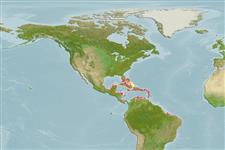Biemna caribea Pulitzer-Finali, 1986
| Native range | All suitable habitat | Point map | Year 2050 |

|
| This map was computer-generated and has not yet been reviewed. |
| Biemna caribea AquaMaps Data sources: GBIF OBIS |
Adicionar o seu Fotografias
Imagem do Google |
No photo available for this species.No drawings available for Desmacellidae.
Imagem do Google |
No photo available for this species.
Classification / Names Common names | Synonyms | CoL | ITIS | WoRMS
| Poecilosclerida | Desmacellidae
Environment: milieu / climate zone / depth range / distribution range Ecologia
; estuarina; intervalo de profundidade 1 - 3 m (Ref. 108813). Tropical; 25°C - 33°C (Ref. 86836)
Distribuição Países | Áreas FAO | Ecossistemas | Ocorrências | Introduções
Western Central Atlantic: Caribbean.
Length at first maturity / Tamanho / Peso / Idade
Maturity: Lm ? range ? - ? cm
Descrição breve Morfologia
Encrusting: 0.3 - 0.6 cm to branching ramose sponge. Light soft yellow to orange externally and internally. Very soft to the touch, porous surface. Oscules dispersed, with slightly elevated transparent membranes, 0.1 - 0.4 wide. Compressible easy to break (Ref. 415).
Exclusively found on mangrove roots (Ref. 415).
Life cycle and mating behavior Maturidade | Reprodução | Desova | Ovos | Fecundidade | Larvas
Members of the class Demospongiae are hermaphroditic. Life cycle: The zygote develops into parenchymella larva (free-swimming) before settling down on a substrate where it grows into a young sponge.
Referência principal
Referências | Coordenador | Colaboradores
Collin, R., M.C. Díaz, J. Norenburg, R.M. Rocha, J.A. Sánchez, M. Schulze, A. Schwartz and A. Valdés. 2005. (Ref. 415)
Categoria na Lista Vermelha da IUCN (Ref. 130435)
Categoria CITES (Ref. 108899)
Not Evaluated
CMS (Ref. 116361)
Not Evaluated
Ameaça para o homem
Harmless
Utilização humana
| FishSource |
Ferramentas
Mais informação
Fontes da internet
BHL | BOLD Systems | CISTI | DiscoverLife | FAO(Publication : search) | Fishipedia | GenBank (genoma, nucleotídeo) | GloBI | Gomexsi | Google Books | Google Scholar | Google | PubMed | Árvore da vida | Wikipedia (ir para, procurar) | Registo zoológico
Estimates based on models
Preferred temperature
(Ref. 115969): 26.4 - 28.4, mean 27.3 (based on 220 cells).
Categoria de preço
(Ref. 80766):
Unknown.


